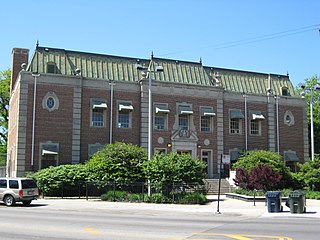Haeger Potteries was a pottery manufacturer established in 1852 and based in Kane County, Illinois.

Haeger Potteries was a pottery manufacturer established in 1852 and based in Kane County, Illinois.

The company started as a Dundee, Illinois brickyard along the Fox River in 1852, using clay from the riverbank. David H. Haeger, a German immigrant, became part owner of the Dundee Brickyard in 1871. Within a year Haeger was sole owner and had extended the business to include tiles. After the Great Chicago Fire of 1871, Haegar shipped bricks into the city to help rebuild Chicago. By the 1920s the brickyard's production included teaware, luncheonware, crystal and glassware. At the Century of Progress Exposition in 1934 in Chicago, Haeger Potteries' exhibit included a working ceramic factory where souvenir pottery was made. [1]
In 1934, Royal Arden Hickman (1893–1969) joined the firm to design a line of artware sold under the brand name "Royal Haeger". [2] Hickman was the chief designer from 1938-1944. [2] Items produced during Hickman's tenure are marked "Royal Haeger by Royal Hickman U.S.A. R-###". During the 1950s, Hickman, no longer employed by Haeger Potteries, contributed designs to the company as a freelancer. Hickman's "iconic black panther, a sleek elongated stalking cat first produced in 1941," has been a decorative "staple in Black households since the '80s and '90s" and was featured in the 2024 video for Kendrick Lamar's "Squabble Up." [3] [4]
Haeger pieces have become collectible in recent years. [5] The original Haeger Potteries Plant is found in the Dundee Township Historic District. Haeger also had a plant in Macomb, Illinois, which has since been demolished.
Alexandra Haeger Estes, great granddaughter of founder David Haeger, became president of the company in 1979. She announced on April 6, 2016 Haeger Potteries anticipated ceasing operations in May 2016, after 145 years in business. [6] [7]

Josiah Wedgwood was an English potter, entrepreneur and abolitionist. Founding the Wedgwood company in 1759, he developed improved pottery bodies by systematic experimentation, and was the leader in the industrialisation of the manufacture of European pottery.

East Dundee is a village in Kane County with a small section in Cook County. The population was 3,152 at the 2020 census.

Belmont Cragin is one of 77 officially designated Chicago community areas located on the Northwest Side of the City of Chicago, Illinois. It is designated Community Area 19, and is located 8 miles (13 km) NW of the Loop. Surrounding community areas include: Portage Park, Hermosa, Austin, Montclare, Dunning.

The American Terracotta Tile and Ceramic Company was founded in 1881; originally as Spring Valley Tile Works; in Terra Cotta, Illinois, between Crystal Lake, Illinois and McHenry, Illinois near Chicago by William Day Gates. It became the country's first manufactury of architectural terracotta in 1889. The production consisted of drain tile, brick, chimney tops, finials, urns, and other economically fireproof building materials. Gates used the facilities to experiment with clays and glazes in an effort to design a line of art pottery which led to the introduction of Teco Pottery. American Terra Cotta's records are housed at the University of Minnesota and include original architectural drawings.
Spring Hill Mall was a shopping mall in West Dundee, Illinois. The mall's anchor tenants are currently Kohl's and Cinemark. There are four vacant anchor stores that were once Carson Pirie Scott, Sears, Macy's, and Barnes & Noble.
The Fostoria Glass Company was a manufacturer of pressed, blown and hand-molded glassware and tableware. It began operations in Fostoria, Ohio, on December 15, 1887, on land donated by the townspeople. The new company was formed by men from West Virginia who were experienced in the glassmaking business. They started their company in northwest Ohio to take advantage of newly discovered natural gas that was an ideal fuel for glassmaking. Numerous other businesses were also started in the area, and collectively they depleted the natural gas supply. Fuel shortages caused the company to move to Moundsville, West Virginia, in 1891.

The Dundee Township Historic District is a set of sixty-five buildings in Dundee Township, Kane County Illinois. Buildings in the district are found in East Dundee, West Dundee, and Carpentersville. The district represents the development of the upper Fox River Valley from 1870 to the 1920s. Dundee Township became an important industrial area, especially following the construction of the Dundee Brick Company in West Dundee and the Illinois Iron and Bolt Company in Carpentersville. Also included in the district are a variety of Queen Anne, Italianate, and Greek Revival style houses and Gothic Revival churches. The majority of the historic district lies within the boundaries of West Dundee. It was added to the National Register of Historic Places in 1975.

Kendrick Lamar Duckworth is an American rapper and songwriter. Regarded as one of the most influential hip hop artists of his generation, and one of the greatest rappers of all time, he is known for his technical artistry and complex songwriting. He was awarded the 2018 Pulitzer Prize for Music, becoming the first musician outside of the classical and jazz genres to be honored.

Gladding, McBean is a ceramics company located in Lincoln, California. It is one of the oldest companies in California, a pioneer in ceramics technology, and a company which has "contributed immeasurably" to the state's industrialization. During the heyday of architectural terra cotta, the company "dominated the industry in California and the Far West."

Good Kid, M.A.A.D City is the second studio album by the American rapper Kendrick Lamar. It was released on October 22, 2012, by Top Dawg Entertainment, Aftermath Entertainment and Interscope Records. The album features guest appearances from Drake, Dr. Dre, Jay Rock, Anna Wise and MC Eiht. It is Lamar's first major label album, after his independently released first album Section.80 in 2011 and his signing to Aftermath and Interscope the following year.
Digi+Phonics is an American hip hop production team, composed of California-based record producers Tae Beast, Sounwave, Dave Free and Willie B. They currently serve as the main in-house producers for Carson-based record label, Top Dawg Entertainment. Digi+Phonics work significantly on projects from all the members of hip hop supergroup Black Hippy, who are also signed to Top Dawg and is composed of rappers Kendrick Lamar, Jay Rock, Schoolboy Q, and Ab-Soul. Their best known productions include "Bitch Don't Kill My Vibe" by Kendrick Lamar, "There He Go" by Schoolboy Q, and "Terrorist Threats" by Ab-Soul. They frequently co-produce songs together and put the finishing touches on the projects released by Top Dawg Entertainment.
"Money Trees" is a song by American rapper Kendrick Lamar, taken from his major label debut studio album Good Kid, M.A.A.D City (2012). The song, which appears as the fifth track on the album, features a guest appearance from his Black Hippy cohort, fellow American rapper Jay Rock, and was produced by DJ Dahi. It entered the Billboard Bubbling Under Hot 100 chart at number 19 due to high downloads, following the album's release. The song, mixed by Top Dawg engineer Derek "MixedByAIi" Ali, features background vocals from American singer Anna Wise of Sonnymoon. Money Trees samples the Beach House song "Silver Soul", from their 2010 album Teen Dream, as well as vocals from Lamar's "Cartoon and Cereal" and interpolates lyrics from E-40's "Big Ballin' With My Homies".

"Collard Greens" is a song by American hip hop recording artist Schoolboy Q, released on June 11, 2013 as the lead single from his third studio album Oxymoron (2014). The song, produced by production team THC and co-produced by Gwen Bunn, features a guest appearance from his Black Hippy cohort, Top Dawg Entertainment labelmate, and fellow American rapper Kendrick Lamar. The song has since peaked at number 92 on the Billboard Hot 100 and number 36 on the UK R&B Chart. It was met with generally positive reviews from music critics.
David Isaac Friley, known professionally as Dave Free, is an American filmmaker and record producer. Born and raised in Inglewood, California, he is best known for his creative partnership with rapper Kendrick Lamar. During his tenure as co-president of Top Dawg Entertainment (TDE), Free directed music videos and short films with Lamar under the name the Little Homies. Following his departure from TDE in 2019, he co-founded the creative company pgLang with Lamar. Among Free's accolades are one Grammy Award and three MTV Video Music Awards.
"Alright" is a song by American rapper Kendrick Lamar featured on the artist's third studio album, To Pimp a Butterfly (2015). The song expresses ideas of hope amid personal struggles and features uncredited vocals in its chorus from co-producer Pharrell Williams. "Alright" was released to radio stations as the album's fourth single on June 30, 2015. Many music publications considered it among the best songs and videos of the year. "Alright" received four nominations at the 58th Grammy Awards: Song of the Year, Best Music Video, Best Rap Performance and Best Rap Song, winning the latter two. It was also nominated for a MTV Video Music Award for Video of the Year.
Garden City Pottery was founded in 1902 in San Jose, California, with an office and manufacturing facility on 560 North Sixth Street. Like many Californian potteries of that period, their original product lines focused on commercial tile and pipe, sanitary and gardenware products, and by the 1920s, Garden City was the largest pottery in Northern California.

"Humble" is a song by American rapper Kendrick Lamar. It was released on March 30, 2017, along with its music video, by Top Dawg Entertainment, Aftermath Entertainment and Interscope Records. The song was written by Lamar and producers Mike Will Made It and Pluss. The lyrics are a call to humility. It was provided to rhythmic contemporary radio as the lead single from Lamar's fourth studio album, Damn.

The soundtrack for the 2018 American superhero film Black Panther, based on the Marvel Comics character of the same name and produced by Marvel Studios, consists of an original score composed by Ludwig Göransson and original songs performed or curated by Kendrick Lamar. Göransson worked on all of director Ryan Coogler's previous films, while Lamar and Coogler had previously discussed collaborating and the musician agreed to perform several songs for the film after seeing an early version of it.

"All the Stars" is a song by American rapper Kendrick Lamar and American singer SZA. Written alongside Anthony "Top Dawg" Tiffith and producers Sounwave and Al Shux, the song was released on January 4, 2018, as the lead single to the soundtrack album of the film Black Panther. Its release coincided with Top Dawg Entertainment's announcement that Tiffith and Lamar would be producing the Black Panther soundtrack album. Marvel Studios confirmed the news and revealed that Lamar was hand-picked by Black Panther's director Ryan Coogler to produce the soundtrack album. The song appeared in the movie's end credits.

GNX is the sixth studio album by American rapper Kendrick Lamar. It was released as a surprise album through PGLang and Interscope Records on November 22, 2024. Titled after the Buick Regal model, and a follow-up to Mr. Morale & the Big Steppers (2022) and his feud with Canadian rapper Drake, GNX is Lamar's first album after his departure from longtime labels Top Dawg Entertainment and Aftermath Entertainment.